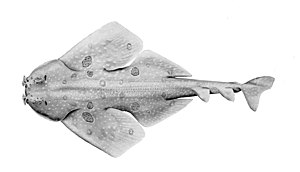Ornate angel shark
| Ornate angel shark | ||||||||||||
|---|---|---|---|---|---|---|---|---|---|---|---|---|

Ornate angel shark ( Squatina tergocellata ) |
||||||||||||
| Systematics | ||||||||||||
|
||||||||||||
| Scientific name | ||||||||||||
| Squatina tergocellata | ||||||||||||
| McCulloch , 1914 |
The Ornate Angel Shark ( Squatina tergocellata ) is a ground-dwelling shark that is found in the south-western coastal area of Australia .
Appearance and characteristics
The Ornate Angel Shark can reach a maximum body length of about 140 cm. As with other angel sharks, the body is strongly flattened with very broad pectoral fins , which makes the animals look more like long rays in shape . However, the pectoral fins are clearly separated from the trunk, while in most rays they merge seamlessly into the body. They have two dorsal fins and no anal fin . The body has a light yellow-brown back color with gray-blue and white spots. There are also three paired eye spots that have a dark ring around an ornamented center. There are enlarged thorns on the muzzle area, there are no thorns on the back.
The eyes lie on the top of the head with a strongly concave surface between the eyes, the mouth is terminal, the outer nostrils are provided with short barbels . The injection holes are small, the number of side gill openings is five. The nasal flaps and barbels are badly frayed.
distribution
The distribution area of the Ornate Angel Shark is in the coastal area of south-western Australia from South Australia to Western Australia . It can be found on the outer edge of the continental shelf at depths of 130 to 400 meters, mostly around 300 meters, whereby the young animals usually live at shallower depths.
Way of life
Like other angel sharks, it feeds primarily on small bony fish and cephalopods , which it prey on lying on the ground as a lurker . He's also likely to swallow mud to neutralize poisons from prey.
Like all angel sharks, it is ovoviviparous - the eggs are hatched in the mother before the young are born alive. The females of this species give birth to two to nine young animals with a length of 33 to 42 centimeters after a 6 to 12 month gestation period. The animals reach sexual maturity with a body length of about 80 to 90 centimeters.
Danger
The International Union for Conservation of Nature (IUCN) classifies this shark as not endangered ("Least Concern"). The species is fished and is also threatened by bottom and trawl fishing, which, however, usually takes place at a maximum depth of 120 to 180 meters, which means that a large area of the distribution areas is below the fishing depth. Since the catches and therefore probably also the stocks are stable, the species was classified as not endangered. However, according to the IUCN, further monitoring is necessary , largely due to the low reproductive rate and potential expansion of commercial fishing.
supporting documents
- ↑ a b Squatina tergocellata in the endangered Red List species the IUCN 2010. Posted by: Kyne, PM & Bennett, MB (SSG Australia & Oceania Regional Workshop, March 2003), 2003. Accessed December 28 of 2010.
literature
- Leonard Compagno , Marc Dando, Sarah Fowler: Sharks of the World . Princeton University Press , Princeton and Oxford 2005, pp. 146-147 ISBN 978-0-691-12072-0 .
